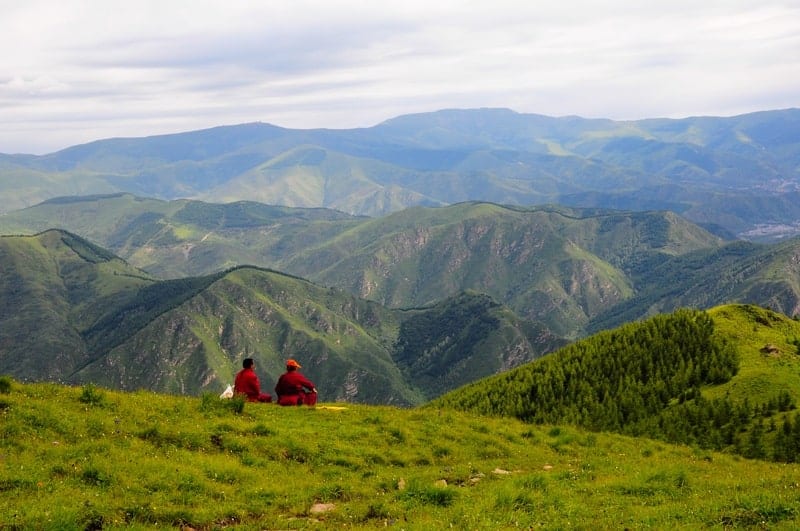As the most mountainous region in East Asia, Taiwan is a country filled with surreal mountain ranges. You’re able to experience stunning hiking trails, lush forests, majestic waterfalls and more. They’re all part of the country’s charm.
According to Common Wealth, Taiwan has the highest density of high mountains…in the whole world! Though the country has many more mountains, there are 286 known summits higher than 9,800 feet tall. The country is also home to the 12,966-foot Yushan (Jade Mountain) – the highest in East Asia.
Though we think every Taiwanese mountain is worth visiting, it’s not very practical. And with that many mountains in Taiwan, it’s hard to filter through the mountains worth visiting. So, here are the very best and most famous mountains you should check out while in Taiwan.
RECOMMENDED: Places That Snow in Taiwan
Table of Contents
Best Taiwan Mountains
Not only is Taiwan known for its delicious cuisine, but also their spectacular natural attractions. Having hundreds of mountains and massive mountain ranges make this Asian country the ultimate adventure for avid nature seekers.
That being said, here are the most monumental mountains of Taiwan. These mountains also happen to be the most famous, but are not in order by popularity.
1. Yushan
ELEVATION: 12,966 FT
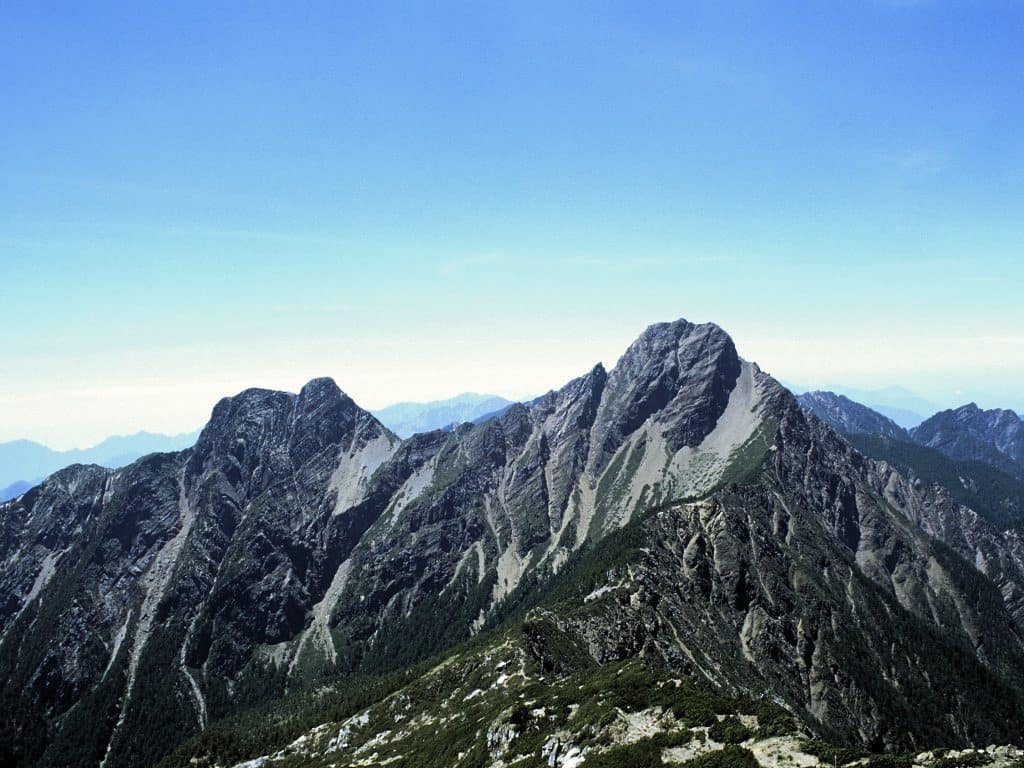
Also known as Jade Mountain, Yushan is the tallest mountain in Taiwan. With a summit peak of 12,966 feet high, this mountain is not just the tallest in Taiwan, but in all of East Asia. It’s just that spectacular of a natural wonder.
Just for comparison, Mount Everest (tallest mountain in the world) is an astonishing 29,029 feet high. So while Jade Mountain isn’t really close to the highest in the world, it’s still very impressive considering it was formed on a relatively small island.
Yushan is a mountain range located in the dead center of the island. It’s situated just on the border of Nantou County, but also to the right of Yunlin Country. But because it’s relatively close to the popular Sun Moon Lake, some extreme adventurers will make the 19 hour hike to the mountain range.
What makes this place special is that it’s the only place on the Tropic of Cancer where scientists have observed evidence of glaciation. In other words, a time period during the ice age where “glacier advances” had happened.
It’s worth noting that Yushan was formed because of the two tectonic plates that the mountain range sits on: the Eurasian and Philippine Sea plates. These two massive tectonic plates had merged so many years ago to give us one of the most remarkable natural attraction in Taiwan.
Visiting Yushan (Jade Mountain)
Depending on where you decide to travel from, this trip can end up taking several days. Because it’s not close to Taipei, traveling from the capital will require at least half of day to the mountain alone.
And if you want to have a meaningful hike or want to reach the mountain peak, then you’ll likely need between 2 and 4 days. It really depends on how fast you want to hike and your conditioning.
Because Jade Mountain is so vast, there’s more than one entrance (or trailhead) for the mountain. In fact, there’s four visitor centers to choose from. But if you’re trying to go to the main peak (which we recommend), you’ll need to start at the Tataka Visitor Center.
If you’re traveling from Taipei, you should take the Taipei High Speed Rail to the Chiayi Station. From there, you’re directly west of Tataka Visitor Center. My suggestion would be to travel by car to your destination, because it’ll still take around 2 to 3 hours by car.
However, if you’re like some tourists and plan to visit Sun Moon Lake prior to Yushan, you may want to consider taking the Yuanlin Bus 6739. It’ll take you directly from Sun Moon Lake to Tataka Visitor Center. Plus, it also goes to Alishan – another fantastic Taiwan mountain.
2. Alishan
ELEVATION: 8,737 FT
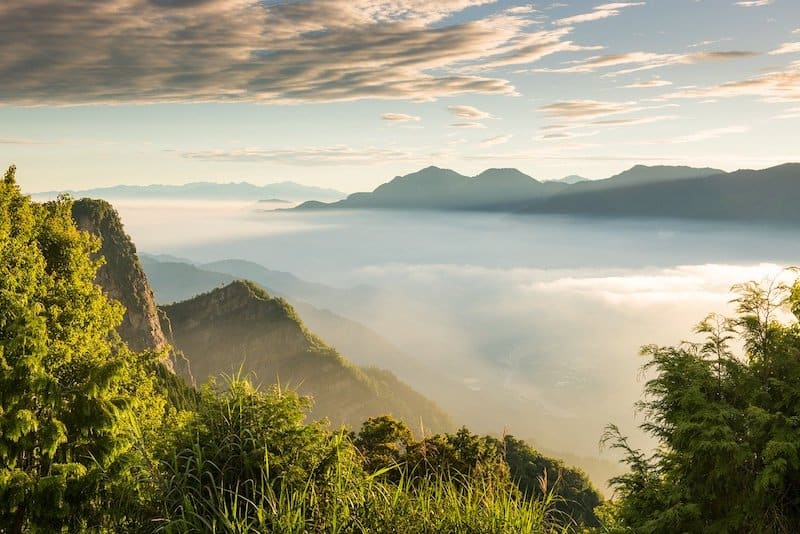
Alishan is a Taiwanese mountain range with a summit that boasts the “best sunrise” in all of Taiwan. The area is popular with tourists along with climbers, and is undeniably the most visited mountain in the country.
There’s a lot to do and see at Alishan. Along with 415 square kilometers of lush wilderness, there’s 4 unique villages, majestic waterfalls, tea plantations, wasabi farms, an old railway and a vast selection of beautiful hiking trails. No matter who you are, there’s something for you.
The mountain is most famous for its high altitude tea. So, if you have the opportunity to try some, you really should grab a cup! Even in a country that loves its tea so much, the Alishan tea stands out for a reason.
If you’re a morning person, the sunrise is the main attraction at Alishan. Plenty of tourists wake up in the middle of the night to hike to the summit to try to catch the spectacular sight. It’s no ordinary sunrise, though. The sun elevates from a sea of clouds for a jaw-dropping experience.
And if you do start your hike early in the day, you’ll be able to witness a fog-filled forest that makes for a haunting yet serene walk through the woods. It’s truly an amazing experience and thousands of tourists visit this scenic area for this very reason.
Visiting Alishan Mountain
Along with Sun Moon Lake and Taroko Gorge, Alishan is one of the three most popular natural attractions in all of Taiwan. That being said, getting to and hiking Alishan is not as difficult as with the other mountains in Taiwan.
If you’re coming from Taipei, you’ll want to take the High Speed Rail (HSR) from the Taipei station to the Chiayi station. It’ll take 1.5 hours and it’s a bit more expensive, but you’ll save around 2 hours than if you were to take the normal train.
From the Chiayi HSR station, you need to head to the Chiayi Bus station (next to Chiayi TRA station). I suggest taking a short taxi ride, or you can wait for the shuttle bus (signs are in English!). From there, take the bus directly to Alishan.
It’s possible to do the standard trails during a 2 day (1 night trip), but I highly recommend going for at least 3 days. That way, you’ll be able to check out the tea farms and see the world-famous sunrise before heading back.
3. Hehuanshan
ELEVATION: 11,207 FT
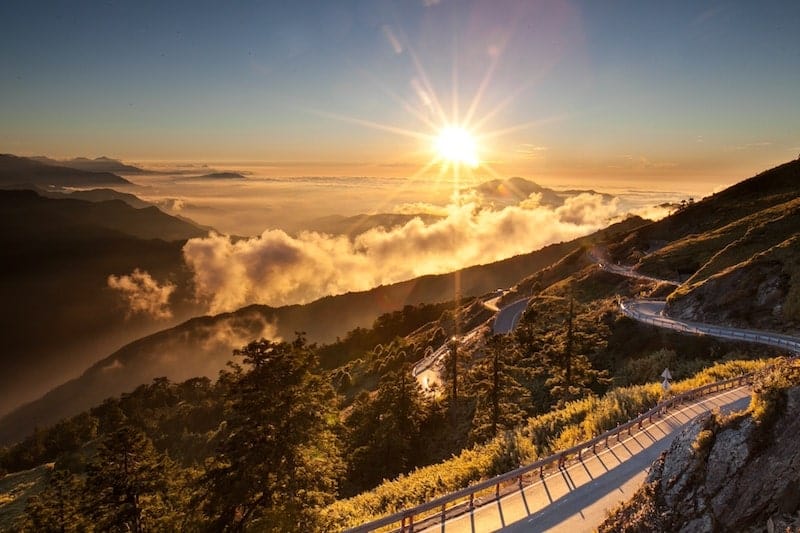
Hehuanshan, also known as “Joy Mountain,” is located inside Taroko National Park and borders the counties of Hualien and Nantou. Despite being well over 11,200 feet tall, Hehuanshan doesn’t even crack Taiwan’s top 40 highest mountains list (it’s number 43).
Still, this mountain range is one of the more famous of the mountainous country, and for good reason. While snow is relatively rare around the island, snow is fairly common at the peaks of Hehuanshan during the colder winter months. For many locals, this is the easiest ways to experience snow in Taiwan.
However, in the warmer months, the Hehuan Mountain is just as stunning. As the summer sun shines down on the elevated mountain, the white wonderland slowly transforms into a lush grassland with an eerie mist engulfing the peaks of the mountain.
What makes this Taiwanese mountain unique is the layer upon layers of mountains which create a surreal scenery straight from one of those old Chinese paintings. Combined with the mysterious fog and you have one of the most spectacular views in all of Taiwan.
Some of my favorite things to do at Hehuanshan is stargazing under the vast sky and watching the sunrise above the sea of clouds. If this sounds ideal to you, make sure to go with a tour agency.
Visiting Hehuanshan (Joy Mountain)
Most mountains in Taiwan that are this high in elevation are relatively difficult to reach the peak (or somewhere near it). You have to be well prepared – packing tons of food and equipment for a potentially multiple-day journey. However, that’s not the case with Hehuanshan.
Of all the “high mountains” in Taiwan, Hehuanshan is one of the easiest for visitors to reach the main peak. From the base downtown, it’s only a 3 hour drive to reach the Wuling Mountain Pass (altitude of 3275 meters). From there, you’ll need to hike roughly 1 hour to reach the main peak. Easy enough, right?
There are plenty of tours that will make the 3 hour journey on a daily basis. Tons of buses go up this mountain. But if you want to try public transportation, you can take the bus from the Nantou Bus Company at the Taichung HSR Station.
Make sure to take the bus to Ching Jing Farm Station (清境農場) and transfer to the Puli bus to go directly there. If you want more information on the schedules of these buses, check out the official site here.
4. Xueshan
ELEVATION: 12,749
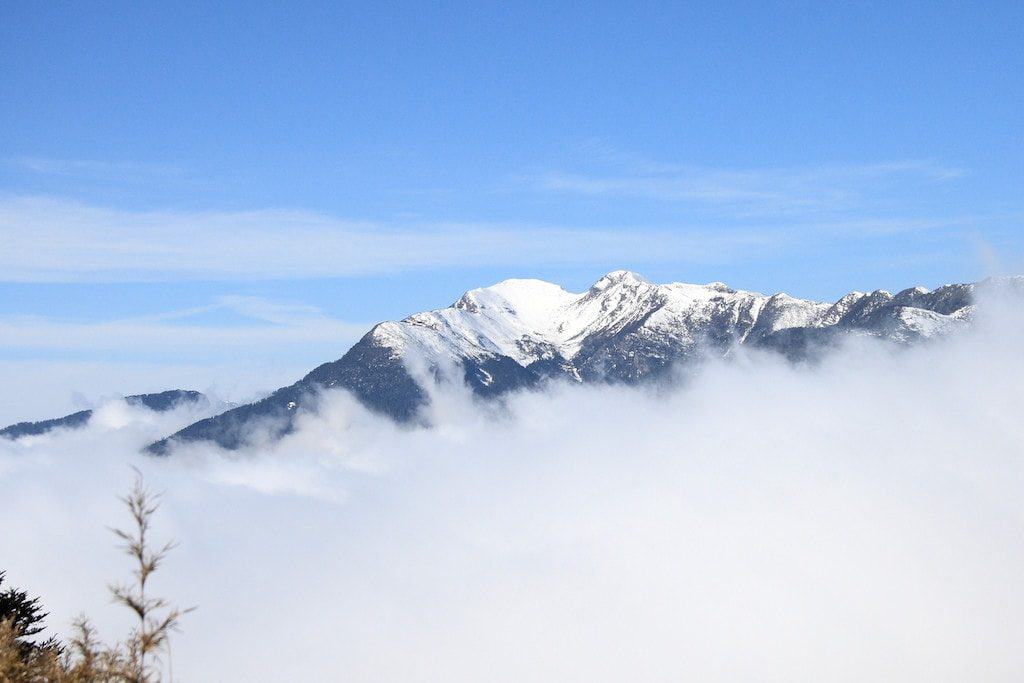
Xueshan is the second tallest mountain in Taiwan, only behind Yushan. Also called “Snow Mountain,” the magnificent mountain is just a few hundred feet shorter than Yushan. And for many years, it was mistakenly believed to be the tallest on the island.
It wasn’t until when colonial Japan occupied Taiwan that this was sorted out. After researchers officially measured both mountains, they discovered that Xueshan was in fact shorter than Yushan. For this reason, the Japanese renamed the mountain to Tsugitakayama, which meant the “second tallest mountain.”
In addition, this mountain has had many different names in the past. Before the western world decided to call it “Snow Mountain,” it was called Mount Sylvia during the age of the Qing Dynasty.
Climbing this mountain is not for the casual hiker. It requires proper equipment, a certified permit, multiple days and a tour guide is highly recommended. Many people also experience altitude sickness during their journey through Xueshan.
However, if you can get past the tree line in this relatively difficult climb, then stunning views the rest of the way is well worth it. Air is fresh, mountain is clean and you’re surrounded by all types of lush greens.
Visiting Xueshan (Snow Mountain)
Seeing Xueshan is not as simple as taking a bus to the trailhead and immediately beginning your hike. You need to be well prepared, especially if you plan to reach the summit peak.
You do need to apply for a permit, and it’s recommended that you apply several months in advance. For busy season, you may have to apply much earlier. The government only issues a certain number of permits every month. So, plan accordingly.
Situated in Heping District of Taichung means that Xueshan is slightly more accessible than Yushan. If you’re traveling from Taipei, you want to head to Yilan (where the base point is). There are several buses at Taipei Main Station that will take you there (45 minutes).
After arriving at the Yilan bus station, transfer to the Kuo-Kuang Bus and head to the Wuling Farm Bus Station. If you want to learn more about the schedules and information on transportation, check out their official website.
5. Yangmingshan
ELEVATION: 3,674 FT
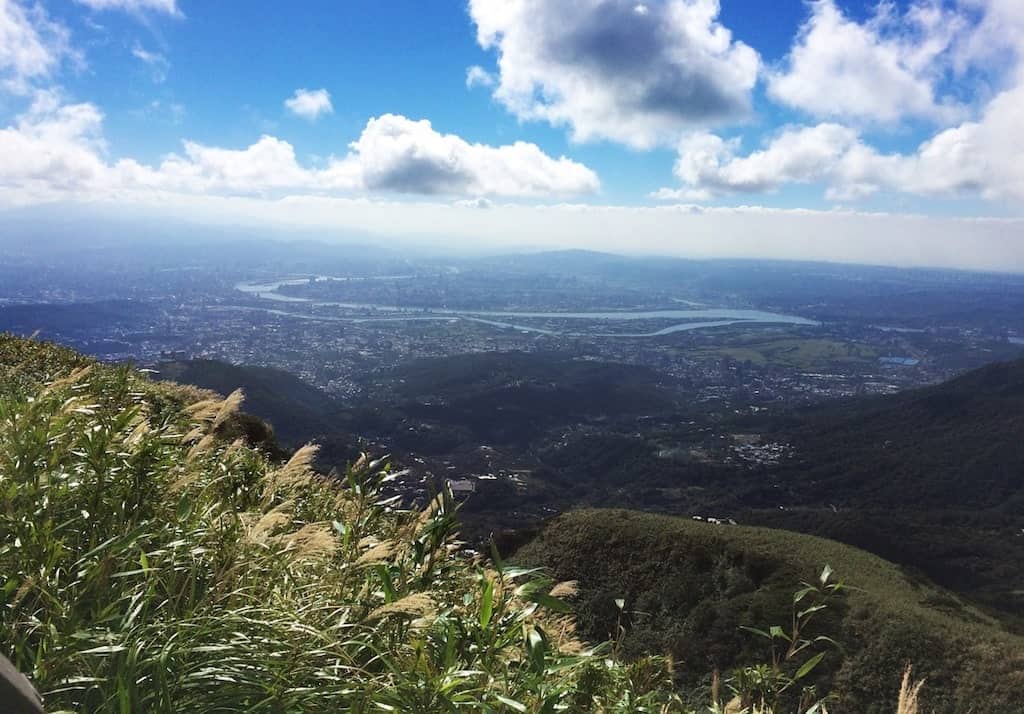
Yangmingshan is one of the more popular mountains in Taiwan due to its close proximity to Taipei (Taiwan’s capital) and relative ease of getting to. Located just north of Taipei, Yangmingshan is not a tall mountain. Rather, it’s an inactive volcano that formed hundreds of thousands of years ago.
Fortunately, volcanic activity subsided roughly 300,000 years ago after the formation of Mount Shamao. However, clear signs of post-volcanic activity is still seen around Yangmingshan. Everything from the several hot springs (including Beitou Thermal Valley) to the fumaroles areas can still be found nearby.
Previously called Daiton National Park during the Japanese colonization, Yangmingshan is Taiwan’s first national park. However, the mountain range was called “Grass Mountain.” Officials regularly set fires on the mountain to prevent thieves from stealing sulfur from the deposits. So, only grass could be seen on the mountain (no trees).
The post-volcanic geological landscape of Yangmingshan is an amazing sight to see. No matter where you go, you’ll find unique ridges, vast valleys, beautiful lakes and majestic waterfalls. All of which, are highlighted by the lush green of the mountainous national park.
Visiting Yangmingshan Mountain
If you’re a mountain-person and you’re in Taipei, Yangmingshan is the place to visit. Of all the mountains of Taiwan, it’s probably the easiest and quickest to get to from Taipei.
There are so many ways you can get there. From Taipei Main Station, you can take Bus 260 directly to the mountain top. By taking the MRT Red Line to Jiantan MRT Station, you’ll have more options. You’ll be able to take Red 30 and the 208 Bus to the Yangmingshan bus station.
After getting off at the bus station, follow the signs to the visitor center. The walk should take around 10 minutes to get to. If you can rent a scooter or car, I’d suggest doing so to be able to visit the multiple viewpoints and attractions within the park.
There are quite a few spectacular places you can check out in Yangmingshan. I’d suggest the following places: Yangmingshuwu, Xiaoyoukeng, Erziping, Datun Nature Park and Lengshuikeng. Trying to see everything in a single day will be tough, so pick your spots or come back another time.
6. Taipingshan
ELEVATION: 6,562 FT
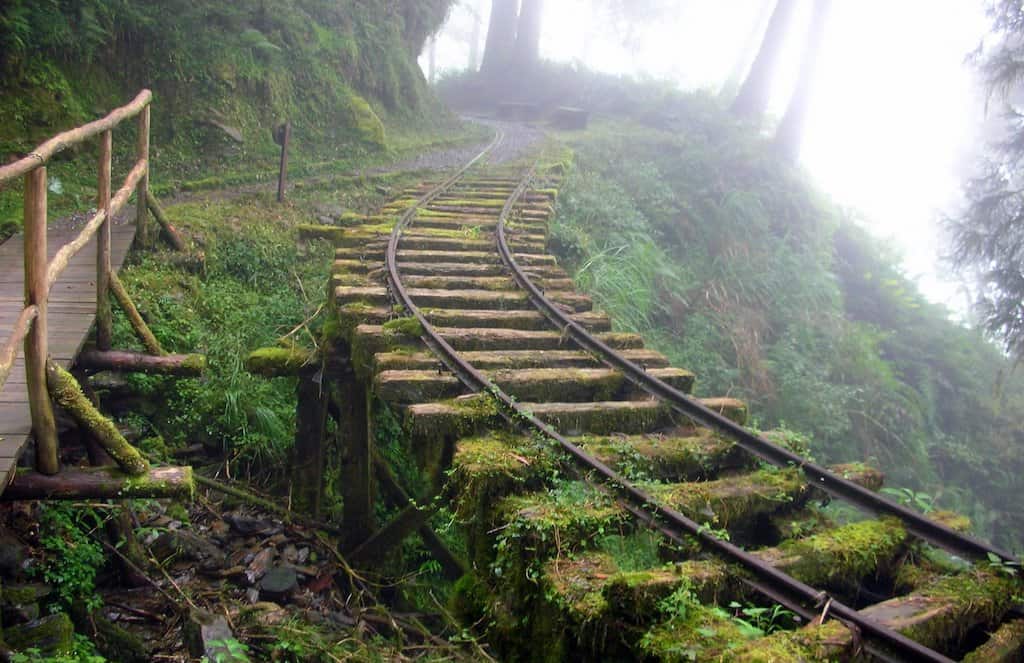
Taipingshan, also known as Taiping Mountain, is a National Forest Recreation area located in Yilan County of Northeastern Taiwan. In my opinion, Taipingshan is one of the most underrated mountains in Taiwan.
The windy road up the mountain can make you queasy, but the beautiful trails, viewpoints, wildlife and unique trees make it all worth the drive. And unlike other Taiwanese mountains, Taipingshan has attractions that appeal to many types of people.
Nature lovers can catch the beautiful sunrise at Cueifong Lake. For those looking to relax a little, the Jioujhihze Hot Springs is a fantastic option for some R&R. Want to check out the spectacular nature without the tiring hikes? Head on over to the Bong Bong Train through the lush green forest (see operating hours here).
My favorite part of the Taipingshan National Forest is the historic Jancing Trail. Otherwise known as the old “forest railway” trail, Jancing trail is a relatively easy hike. It’s roughly 5.5 km long, but the natural beauty that surrounds the abandoned railway easily puts it on top of my Taiwan bucket list.
Visiting Taipingshan Mountain
If you’re traveling to Taipei, then getting to Taipingshan isn’t difficult. There are plenty of public transportation options, but the easiest and most convenient would be by bus.
From Taipei Main Station, you can take the numerous buses to Yilan Bus Station. After arriving, take the Kuo Kuang Bus to Taipingshan. Make sure to check out the schedules and routes for the bus. You can check that out here.
My favorite time of the day to visit Taipingshan is in the morning when the eerie fog lingers around the thick forest. It creates an atmosphere that’s both serene and gorgeous – perfect for a photo opportunity. However, the best time of the season to visit is during fall when the beautiful colors of the forest leaves are highlighted.
The air is fresh and the climate is cool up in the mountains of Taipingshan. So if you do plan to go during summer, you’ll be pleasantly surprised with the favorable temperatures. If you’re in Taipei or plan to visit Yilan County, Taipingshan is an attraction you won’t want to miss!
7. Sixty Stone Mountain
ELEVATION: 2,625 FT

The actual name of this Taiwanese mountain is Mount Luishidan, which directly translates into “sixty stone mountain” or “sixty rock mountain.” Despite its relatively low elevation, Sixty Stone Mountain has quietly become a secret natural attraction that’s…well, not so secret anymore.
Situated on the eastern coast of Taiwan in Hualien County, Sixty Stone is often overlooked by more famous nearby mountain ranges, such as Hehuanshan inside Taroko National Park. Even so, this mountain has wonderful views, ease of transportation and best of all, yellow daylilies.
That’s right! Most of the tourists come to this mountain every year to get a glimpse of the lilies in full blossom. The yellowness covers the mountain and gives you an unbelievable sight that you won’t be able to find anywhere else in Taiwan.
Though the lilies are typically the main attraction, there are other things to do. The mountain has some great viewpoints where you’re able to overlook Huadong Valley and Taiwan’s central mountain range. If you get hungry, there are many unique local dishes to try, such as lily soup and fried lily flowers.
Visiting Sixty Stone Mountain
If you plan to visit this majestic Taiwanese mountain, you probably want to go when the lilies are blooming. That being said, the best time to visit Sixty Stone is between August and October. However, I’d suggest going in September when the lilies are in full force.
From Taipei, you’ll want to make your way to Hualien first. The best way to get to Hualien is probably with the train (TRA), which you can take from Taipei Main Station. From there, you have a few options to get to the mountaintop.
Keep in mind, there will be traffic control up the mountain during the daylily season – so plan accordingly. I’d suggest taking a taxi to the top. It’s the easiest and relatively cheap if you’re going in a group. Alternatively, you can also rent a motorbike and cruise up yourself.
Depending on the traffic control and time of the year, it should take around 1 hour to get to the top. There’s plenty of parking and an observation deck for a spectacular view you won’t want to miss!
8. Dasyueshan
ELEVATION: 11,580 FT
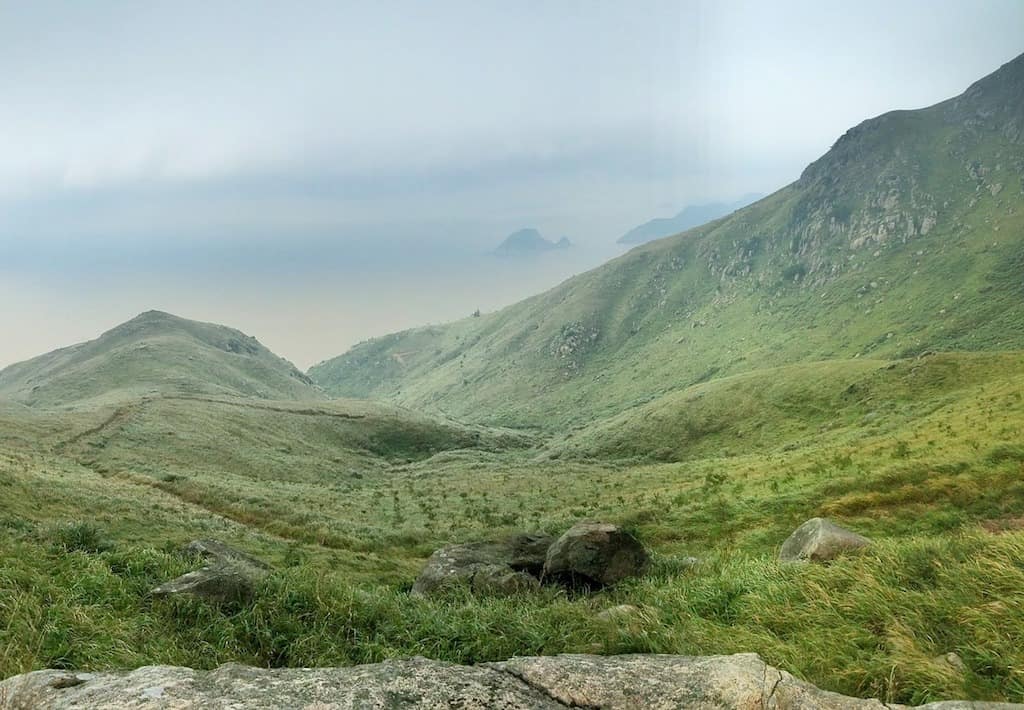
Dasyueshan, sometimes referred to as Daxue Mountain, sits on the Xueshan (Snow Mountain) mountain range. Though not nearly as famous as adjacent mountains, Dasyueshan is still an impressive mountain known for amazing viewpoints and birdwatching.
Dasyueshan is the “mecca” for bird watching in Taiwan. In fact, it’s estimated that there are 601 bird species found on this Taiwanese mountain. For those interested, you can see the full list of birds here. And if you’re into bird watching, there are plenty of bird watching tours you can attend.
But if that’s not your thing, that’s okay. Dasyueshan is fascinating in many other ways, boasting a diverse wildlife, majestic forests, crisp mountain fresh air, a variety of hiking trails, scenic roads and blossoming rhododendrons. Plus, the mountain has modern facilities such as visitor centers and restaurants.
With 200,000 visitors per year, Dasyueshan is still a mountain that’s highly underrated. The best attraction is probably the Yakou Observatory, where visitors get a stunning panoramic view of the mountain range. You can even see Yushan – tallest mountain in Taiwan – from the viewpoint!
Visiting Daxue Mountain
If you plan to visit Dasyueshan, expect a bumpy ride. Because the mountain visitor center can only be reached with the winding Forest Road 200, you may want to take precautions if you easily suffer from motion sickness. But despite the twists and turns, the roads are quite nice.
You’ll want to head to Taichung County if you want to visit this mountain. The Forest Road 200 starts in the Dongshi Dictrict – on the outskirts of Taichung. From there, take the road all the way up to the visitor center. It should take around 1 to 1.5 hour depending on traffic and such.
Unfortunately, there aren’t many options for public transportation. So your best bet is to take a taxi or rent a motorbike. However, if you’re going on the weekend, there will be one bus operating from Dongshi. Take the Fengyuan Bus #252 if that’s your only option.
If the plan is to go bird watching, there should be some groups online that arrange trips. That way, you can carpool with other fellow bird watchers. Signing up for a tour with a private chartered bus is another option too.
9. Xitou Mountain
ELEVATION: 3,773 FT
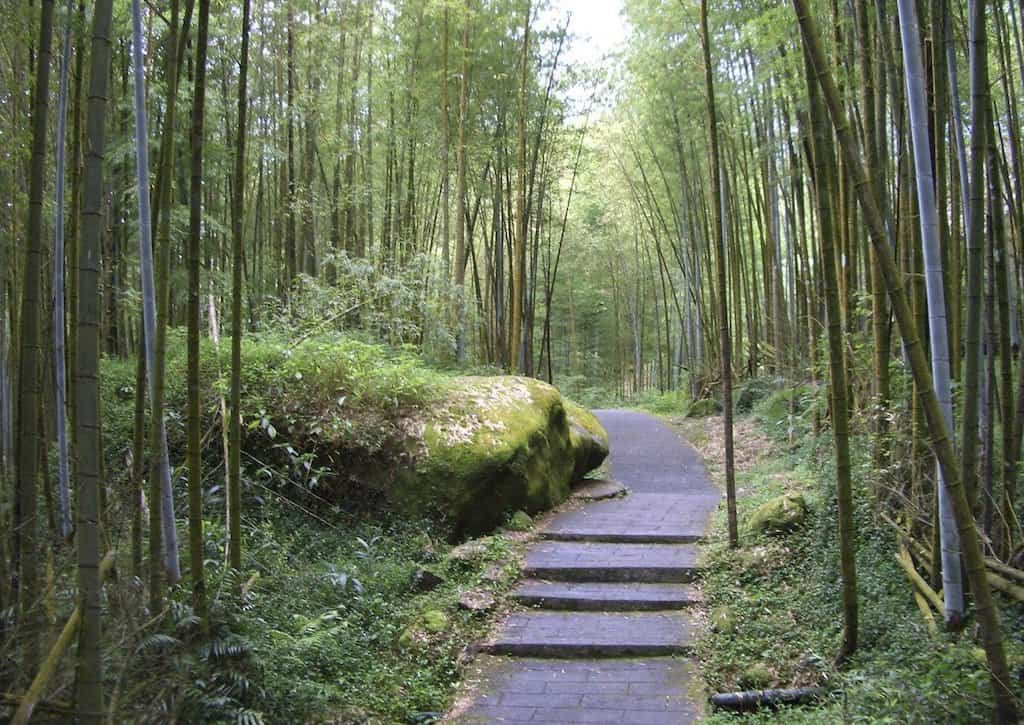
Xitou is a small Taiwanese mountain with one of the most famous forests in the country – the Xitou Nature Education Area. The mountainous area is most known for its astonishing bamboo trails, which is why it’s often referred to as the Xitou Bamboo Forest.
However, Xitou Bamboo Forest is not located on top of the mountain. Instead, it’s situated in the valley of the bordering mountains. It’s also the starting point if you plan to take the several hikes up Xitou mountain. The highest peak you can reach is Mount Lingtou, which is roughly 6,643 FT in elevation.
Because Xitou is an experimental forest for the National Taiwan University, you can expect to find all kinds of unique trees and plants. You’ll find rare cedars, red spruces, redwoods and even a pure ginkgo forest that’s pretty awesome. Nearly everything in this forest have been cultivated by the university!
There are plenty of things to do around Xitou. With a youth activity center, dedicated bird watching areas, hotels, restaurants and camping grounds, there’s something that’ll certainly appeal to everyone.
Visiting Xitou
As one of the most popular attractions in Nantou (only second to Sun Moon Lake), there are plenty of public transportation options to get to Xitou.
If you’re coming from Taipei, you’ll want to take the HSR to the Taichung HSR Station. From there, transfer onto the Taichung Bus (torward Shanlinxi) and take the stop at the Xitou Station. And that’s it – it’s really that easy and convenient to get there.
What’s unique about this place is that clouds roll in around midday. So if you want to go for a hike, make sure to start early so the clouds don’t spoil the breathtaking views. While the misty forest is a cool sight too, the true natural scenery is even better.
Also, it’s worth noting that Xitou is extremely popular on the weekends. You’ll see many buses roll through around 8 or 9 AM and even more senior citizens visiting. So, plan accordingly.
10. Mount Guan
ELEVATION: 12,034 FT
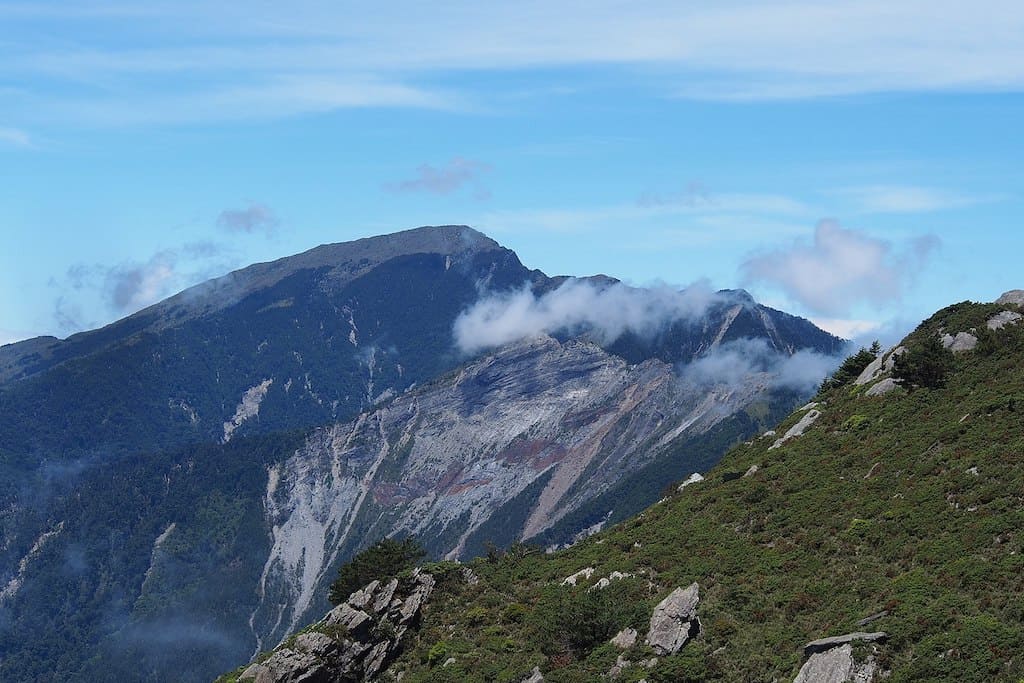
As one of the 10 tallest mountains in Taiwan, Mount Guan (Guanshan) is one that frequently slips under the radar among fellow nature seekers. Because Guanshan sits on the border of Taitung County, it’s not an easy mountain to access. Regardless, thousands of tourists still visit the mountain each year.
From afar, the mountain is breathtaking. It looks like a tall pyramid and unlike most mountains you’ll see in the country. Keep in mind, it’s not a great place for a simple stroll. The hikes are strenuous and if you want to really see the mountain’s beauty, expect to climb a near-vertical rock cliff to get to the top.
And depending on when you visit, the sunrise at Mount Guan is mesmerizing. In the early morning, hikers are greeted with a sky full of color. The pleasant mix of blue, red and orange creates a sight worth waking up at 2 AM for. But if you plan to visit, make sure to be well prepared.
Visiting Guanshan
Mount Guan is not easy to get to, depending on where you’re traveling from. First of all, there’s no high speed rail train that stops in Taitung. Instead, you’ll need to take the much slower train (TRA) from Taipei to Taitung.
From the Guanshan TRA Station, it’s roughly a 2 hour drive to Mount Guan. I couldn’t find any bus routes that went to the mountain, so that leaves you with renting a motorbike or car.
Alternatively, you can negotiate a set price with a taxi driver. It may be hard to find a ride back from the mountain top, so most people rent the taxi driver for the whole day. Depending on the driver, prices can be fairly reasonable.
11. Nanhu Mountain
ELEVATION: 12,277 FT
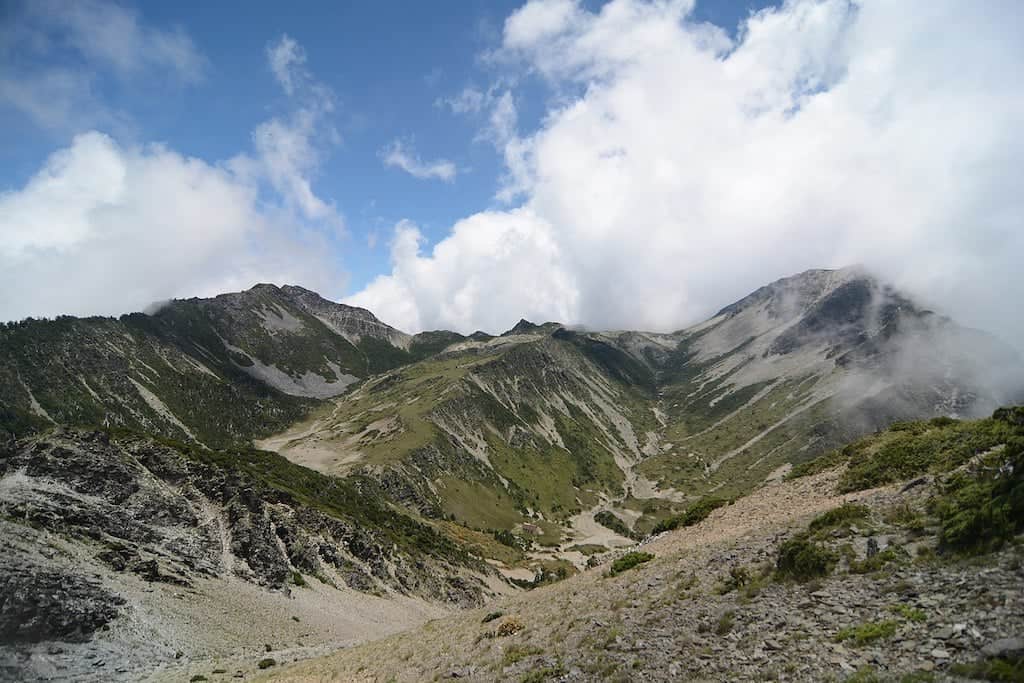
Nanhu Mountain is one of the 5 tallest mountains on the island. Located inside Taroko National Park, Nanhu Mountain sits on the other side of Hehuanshan (also inside Taroko) but is technically part of Taichung County.
This mountain is recommended only for the more experienced trekkers. Expect to spend a few days hiking to the top and back in high altitude elevation. But because it’s located on the northern part of Taiwan’s central mountain range, you’ll inevitably get to see some of Taiwan’s most gorgeous views of the mountain range.
But despite the relatively remote location of Nanhu Mountain, there are some decent facilities along the way. You’ll pass by clear signs, resting areas, bathrooms and even communal lodges for travelers to spend the night. If you’re up for it, this mountain has the 8th (out of 100) best peaks of Taiwan.
Visiting Nanhu Mountain
The timing to visit or climb Nanhu Mountain is very important. During the winter time, the mountain roads are often covered with snow. In fact, it’s one of the very few places in Taiwan that actually gets some snow. So, make sure to check the weather report between December and February.
Because Nanhu Mountain is on the eastern side of the island, it’s subject to heavy winds and rain during typhoon season. While summer may seem like a great time to go, you’ll still need to check the weather report.
The trailhead is about 3 hours from Taipei City. Actually, it’s fairly close to Wuling Farm, which is the trailhead for Xueshan. You’ll want to take the bus or taxi to Yilan County. From there, take the Kuo-Kuang Bus and head to Wuling Farm Bus Station.
12. Xiuguluan Mountain
ELEVATION: 12,549 FT
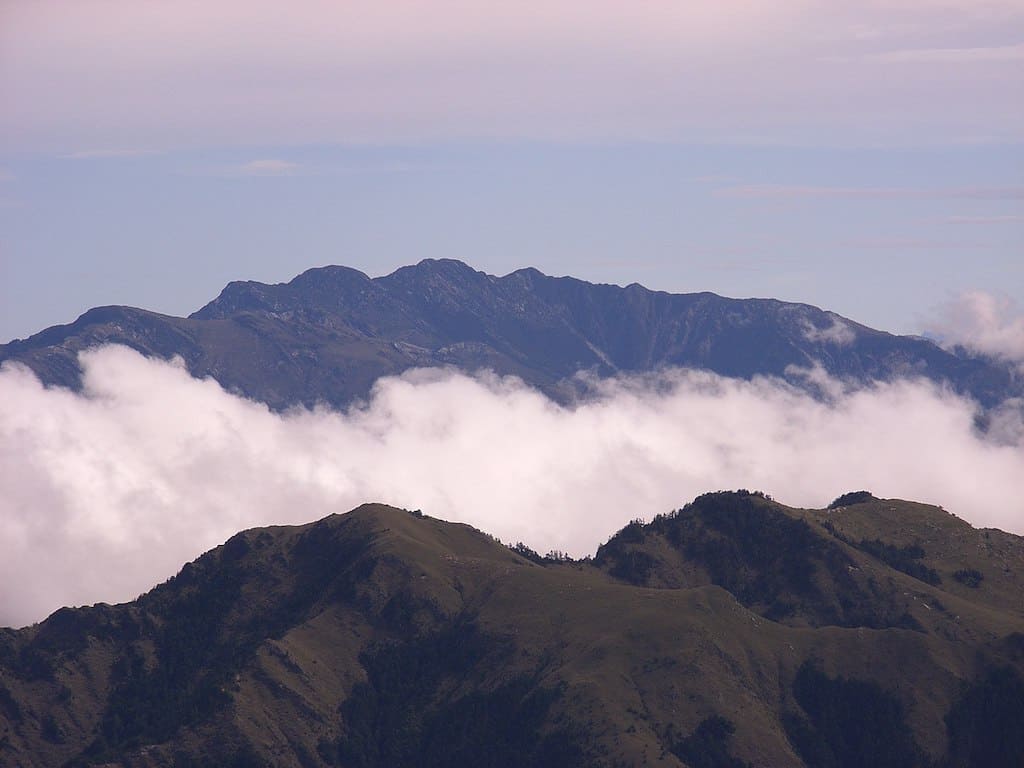
As the third tallest mountain in Taiwan, Xiuguluan Mountain isn’t even the tallest within it’s national park. In fact, this massive mountain is located inside Yushan National Park, where the country’s tallest mountain also sits.
Xiuguluan Mountain is located in the heart of the central mountain range. Among the Taiwanese aboriginal Bunun people, the original name of the mountain was “Macho Las Hill.” In the Bunun language, it directly translates to “very old man,” which describes the snow-capped peaks of the mountain and it’s resemblance to an old man’s white hair.
This Taiwanese mountain is located next to the Xiuguluan River, which for so many years, has cut through the landscape and created the adjacent mountains, such as Xiuguluan Mountain. The river also happens to be one of the most popular river-rafting places in the country.
Like with the other tall mountains of Taiwan, Xiuguluan is a fairly difficult one to conquer. It’s called one of the “big 5 mountains” of Taiwan and many highly experienced mountaineers flock to Xiuguluan every year. Needless to say, heavy preparation is highly recommended.
Visiting Xiuguluan Mountain
Again, Xiuguluan Mountain may experience snow in the winter season. That being said, it’s always best to be prepared. And if you can, I’d suggest going with a group of experienced mountaineers (preferably with a tour).
To conquer this mountain, you’ll want to take the Mabolasi Crossing Trail. To get to the trailhead, you’ll need to head over to Chiayi County. Take the HSR to Chiayi Station. From there, I suggest renting a car to head to the top of the mountain.
Posts you may like:
- 10 Best Taiwanese Islands
- Beitou Thermal Valley
- Inside Wulai Old Street
- Taipei’s Daan Forest Park
- Elephant Mountain Hike
- 5 Best Taipei Night Markets
- Taipei 101 Observatory


